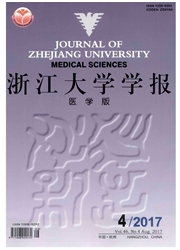

 中文摘要:
中文摘要:
目的:探讨体外葡萄籽原花青素对氯化钴致视网膜神经节细胞RGC-5缺氧损伤模型的保护作用。方法:采用氯化钴(400μmol/L)诱导RGC-5细胞化学缺氧损伤,观察葡萄籽原花青素(40μg/mL )对缺氧的抗损伤作用。以MTT法检测细胞存活率;Hoechst 33342荧光染色法观察细胞凋亡情况;以H2 DCFDA荧光法检测细胞内活性氧的变化;实时定量PCR检测细胞Bcl-2、半胱酰胺天冬氨酸蛋白酶( caspase )9和caspase 3 mRNA水平。结果:与缺氧对照组比较,葡萄籽原花青素预处理可提高细胞存活率( P<0.001)、减少细胞凋亡( P<0.001) ,并减少细胞内的活性氧( P <0.001);葡萄籽原花青素还显著升高 Bcl-2基因的表达( P <0.001) ,显著降低caspase 9和caspase 3基因的表达( P<0.001)。结论:葡萄籽原花青素对氯化钴诱导的视网膜神经节RGC-5细胞缺氧损伤起保护作用,其保护作用可能与细胞内活性氧减少、Bcl-2基因表达上调及casepase 9和casepase 3基因表达下调有关。
 英文摘要:
英文摘要:
Objective: To investigate the protective effects of grape seed proanthocyanidin extracts ( GSPE ) against CoCl 2-induced hypoxic injury in cultured RGC-5 cells.Mtehods: CoCl 2( 400 μmol L/) was used to induce hypoxic injury in cultured RGC-5 cells;the cells were pretreated with 0, 100, 200, 400 and 800μmol/L GSPE for 24h. The cell viability was assayed by MTT; the apoptosis was detected by Hoechst 33342 staining;the intracellular reactive oxygen species ( ROS) was measured by H2DCFDA oxidative reaction.The mRNA expression of Bcl-2, caspase 9 and caspase 3 was determined by real-time PCR.Results: Compared to hypoxic control group, pretreatment with GSPE significantly increased viability of RGC-5 cells ( P 〈0.001 ) , reduced cell apoptosis ( P〈0.001 ) and intracellular ROS ( P〈0.001 ) .In addition , GSPE significantly increased the mRNA expression of Bcl-2 (P〈0.001 ) and decreased mRNA expression of caspase 9 ( P 〈0.001 ) and caspase 3 ( P〈0.001 ) compared to hypoxic control group .Conclusion: GSPE may have a protective effect against CoCl 2-induced hypoxic injury in cultured RGC -5 cells. The decrease of intercellular ROS , up-regulation of Bcl-2 and down-regulation of caspase 9 and caspase 3 may be involved in the mechanism of the protective effect of GSPE .
 同期刊论文项目
同期刊论文项目
 同项目期刊论文
同项目期刊论文
 期刊信息
期刊信息
